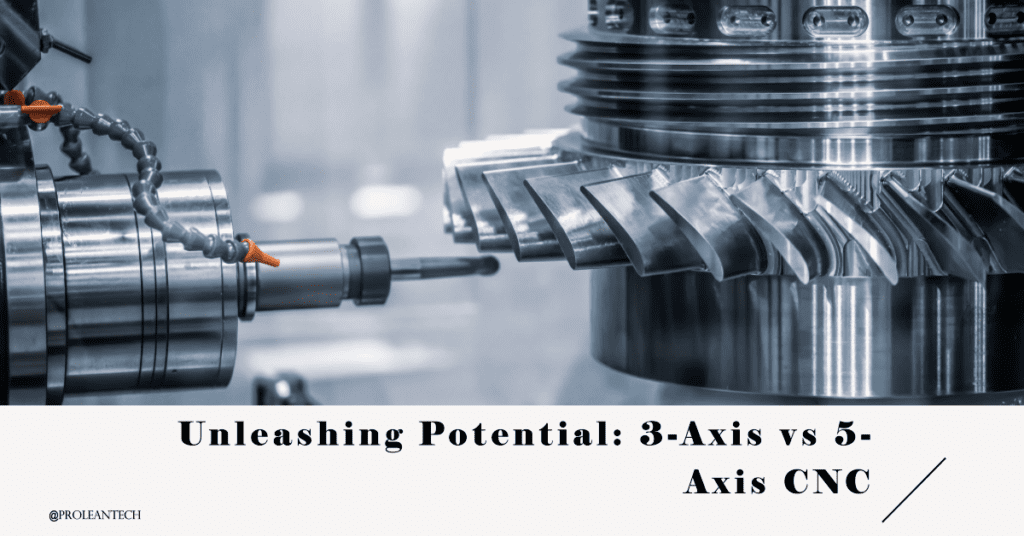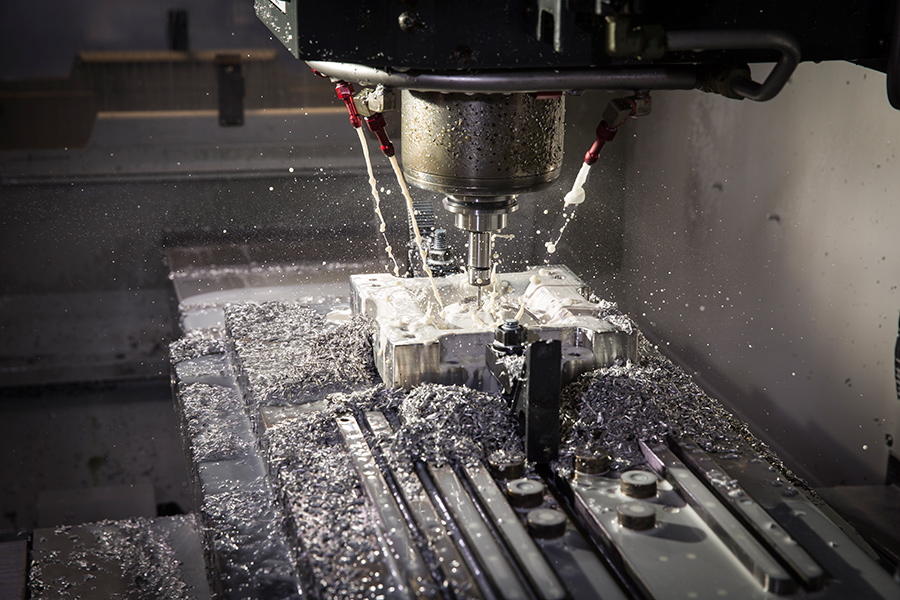
The world of manufacturing has experienced significant evolution over the years, with innovations constantly changing the way we design and create products. A pivotal player in this manufacturing revolution is Computer Numerical Control (CNC) machining, which has given rise to technologies like 3-axis and 5-axis CNC machines. These tools offer an incredible range of capabilities, enabling intricate designs and rapid production.
This article will delve into the specifics of 3-axis and 5-axis CNC machines, shedding light on their operation, advantages, and notable differences.
Understanding 3-Axis CNC Machines
3-axis CNC machines are a staple in the manufacturing industry, offering a straightforward and efficient approach to automated machining.
These machines operate on three axes of motion: the X-axis (left and right), the Y-axis (forward and backward), and the Z-axis (up and down). By controlling these three axes, a 3-axis CNC machine can move the cutting tool or workpiece in three dimensions, allowing for a wide range of parts to be manufactured.
Advantages of 3-Axis CNC Machines
There are several benefits associated with 3-axis CNC machines:
- Simplicity: They are easier to operate compared to their 5-axis counterparts. The programming is less complex, which makes them a great entry point for businesses new to CNC machining.
- Cost-effectiveness: 3-axis machines are typically less expensive to purchase and maintain, making them an affordable option for many businesses.
- Versatility: Despite their simplicity, these machines can create a broad variety of parts and components.
Table: Key Features of 3-Axis CNC Machines
| Feature | Description |
|---|---|
| Axis of Operation | Operates on the X, Y, and Z axes |
| Complexity | Less complex, easier to program |
| Cost | Typically lower initial and maintenance costs |
| Application | Ideal for simpler parts and designs |
Getting to Know 5-Axis CNC Machines

A step up in complexity and capability, 5-axis CNC machines offer an expanded range of possibilities in manufacturing.
5-axis machines operate on the same three linear axes as the 3-axis machines (X, Y, and Z). In addition, they have two more rotational axes that can rotate around X and Y axes, often referred to as A and B axes. This gives these machines the ability to maneuver cutting tools or workpieces in five different directions concurrently, enabling the creation of more intricate and complex parts.
Advantages of 5-Axis CNC Machines
5-axis CNC machines bring several unique advantages:
- Enhanced capabilities: They can produce extremely complex parts with intricate details that would be challenging or impossible for a 3-axis machine.
- Increased accuracy: Because the part can be worked on from many angles in a single setup, there is less chance of error due to resetting.
- Faster production: Multiple sides of a part can be machined in one setup, reducing production time and increasing efficiency.
Table: Key Features of 5-Axis CNC Machines
| Feature | Description |
|---|---|
| Axis of Operation | Operates on the X, Y, and Z axes, plus two rotational axes (A and B) |
| Complexity | More complex, requiring more advanced programming |
| Cost | Typically higher initial and maintenance costs |
| Application | Ideal for intricate, complex parts and designs |
Try Prolean Now!
Comparison of Capabilities: 3-Axis vs 5-Axis CNC Machines
While both 3-axis and 5-axis CNC machines have their unique advantages, understanding their capabilities in comparison can help businesses make the best choice for their specific needs.
1. Range of Movement
3-axis CNC machines operate on three axes: X, Y, and Z. This allows for movement in all three dimensions, suitable for a wide variety of parts. However, 5-axis CNC machines add two more rotational axes to this equation, the A and B axes, permitting the machine to rotate the workpiece or cutting tool around the X and Y axes. This offers more flexibility in terms of the geometries that can be machined and the complexity of the parts that can be created.
2. Complexity of Parts
The added complexity in 5-axis CNC machines allows for the creation of more complex parts with intricate geometries. While a 3-axis machine is efficient for simpler parts and designs, the advanced capabilities of a 5-axis machine make it the superior choice for manufacturing parts with complex surfaces and intricate features.
3. Production Speed and Efficiency
5-axis CNC machines can often complete tasks more quickly than 3-axis machines, as they can machine multiple sides of a part in a single setup. This reduces setup time and increases overall efficiency.
Table: Comparing Capabilities of 3-Axis and 5-Axis CNC Machines
| Capability | 3-Axis CNC Machines | 5-Axis CNC Machines |
|---|---|---|
| Range of Movement | Operates on X, Y, and Z axes | Operates on X, Y, Z plus A (rotates around X) and B (rotates around Y) axes |
| Complexity of Parts | Ideal for simpler parts and designs | Superior for complex parts and designs |
| Production Speed and Efficiency | Less efficient for complex parts | More efficient for multi-sided parts |
Determining the Right CNC Machine for Your Needs
Choosing between a 3-axis and a 5-axis CNC machine for your business can be a daunting task. The best fit depends on various factors, such as the complexity of the parts you aim to produce, your budget, and the skills of your workforce.
1. Assess Your Production Needs
The first step in deciding between a 3-axis and a 5-axis CNC machine is to assess your production needs. If you manufacture simpler parts or components that do not require multi-sided machining in one setup, a 3-axis machine might be sufficient. However, if your production demands involve complex parts with intricate details that need multi-sided machining in one setup, a 5-axis machine would be more suitable.
2. Consider Your Budget
3-axis machines are typically less expensive to purchase and maintain than 5-axis machines. If budget is a primary concern, this could sway your decision. However, remember to consider the long-term efficiency gains a 5-axis machine could offer for complex projects.
3. Evaluate Your Workforce Skills
Operating a 5-axis machine requires a higher level of skill than a 3-axis machine due to the more advanced programming involved. If your workforce lacks the necessary skills, you might need to invest in training or hire experienced operators, which could add to your costs.
Pros and Cons of 3-Axis and 5-Axis CNC Machines
3-Axis CNC Machine
Beyond simply understanding the capabilities of these machines, it’s also vital to consider their advantages and disadvantages.
| Aspect | Advantages | Disadvantages |
|---|---|---|
| Cost | Economical option for many businesses | More expensive to purchase and maintain than 3-axis machines |
| Ease of operation | Easier to operate and program | – |
| Applications | Highly versatile and can be used in a wide variety of applications | – |
| Complexity of parts | – | Cannot handle parts with complex geometries as efficiently as 5-axis machines can |
| Number of setups required | – | When machining a part from multiple sides, a 3-axis machine will need multiple setups. This can increase the machining time and the risk of inaccuracies due to repositioning. |
5-Axis CNC Machine
| Advantage/Disadvantage | 5-Axis CNC Machines | 3-Axis CNC Machines |
|---|---|---|
| Ability to handle complex designs | ✓ | ✕ |
| Single setup machining | ✓ | ✕ |
| Surface finish quality | ✓ | ✕ |
| Cost | Expensive to purchase and maintain | Economical option for many businesses |
| Training requirements | Requires a higher level of skill and more sophisticated software | Easier to operate and program |
| Versatility | ✕ | Highly versatile and can be used in a wide variety of applications |
| Complexity of parts | Superior for complex parts and designs | Cannot handle parts with complex geometries as efficiently as 5-axis machines can |
| Number of setups required | – | When machining a part from multiple sides, a 3-axis machine will need multiple setups. This can increase the machining time and the risk of inaccuracies due to repositioning. |
Conclusion
The debate between 3-axis and 5-axis CNC machines isn’t about which is universally better, but rather which is more suitable for your specific needs. Both machines offer unique benefits, and the choice will depend on the nature of your projects, budget, and workforce capabilities. Whether you choose a 3-axis or a 5-axis CNC machine, both will significantly enhance your manufacturing process with their precision and efficiency.
Remember, Prolean’s CNC Machining Services are here to assist you, offering both 3-axis and 5-axis CNC machining options to meet your diverse manufacturing requirements.
FAQs
Can a 3-axis CNC machine perform the same functions as a 5-axis machine?
No, a 3-axis CNC machine operates on the X, Y, and Z axes, and cannot rotate the workpiece or cutting tool like a 5-axis machine can. This limits its ability to produce parts with complex geometries.
Is a 5-axis CNC machine always better than a 3-axis machine?
Not necessarily. While a 5-axis CNC machine has more advanced capabilities, it is also more expensive and requires more skilled operators. The right choice will depend on your specific needs and resources.
What are the main industries that use 3-axis and 5-axis CNC machines?
Both types of machines are used across a wide range of industries, including aerospace, automotive, healthcare, manufacturing, and many more.
Is it possible to upgrade a 3-axis CNC machine to a 5-axis?
While there are retrofit kits available to upgrade a 3-axis machine to a 5-axis, this process can be complex and costly. It is generally recommended to purchase a dedicated 5-axis machine if your needs require it.




0 Comments